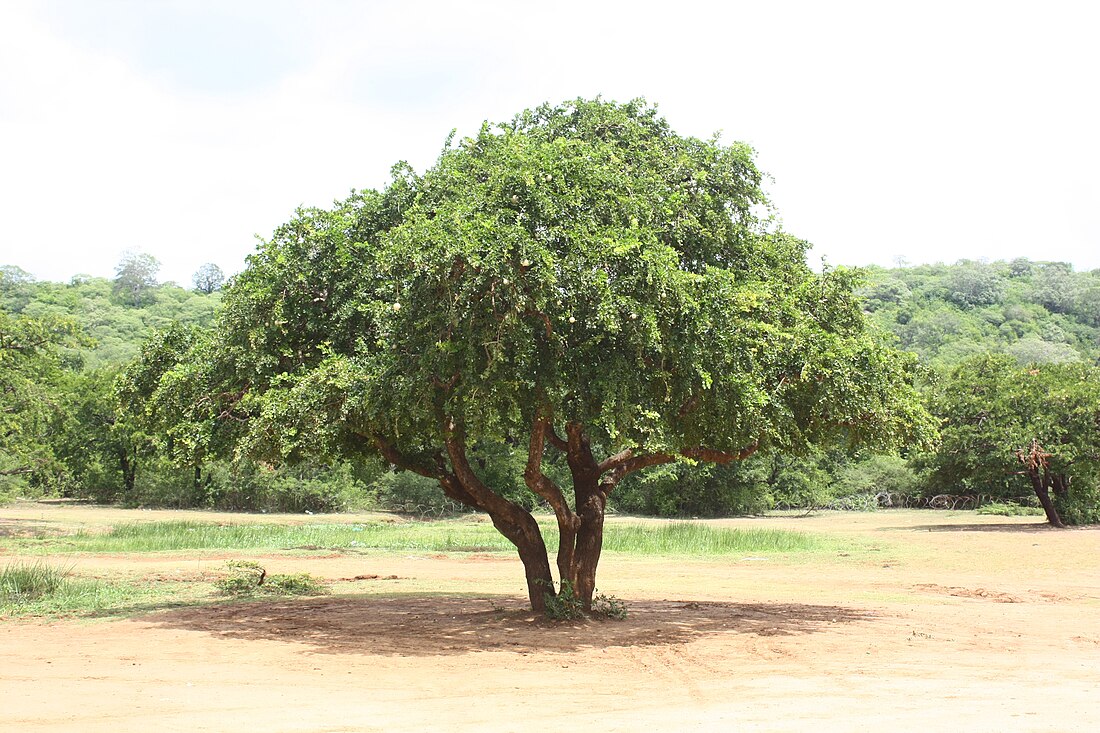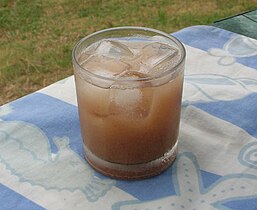Limonia acidissima
Species of tree From Wikipedia, the free encyclopedia
Limonia acidissima is the only species within the monotypic genus Limonia. Common names for the species in English include wood-apple and elephant-apple.[3] It is sometimes also called monkey fruit.
| Limonia acidissima | |
|---|---|
 | |
| In Trincomalee, Sri Lanka | |
| Scientific classification | |
| Kingdom: | Plantae |
| Clade: | Tracheophytes |
| Clade: | Angiosperms |
| Clade: | Eudicots |
| Clade: | Rosids |
| Order: | Sapindales |
| Family: | Rutaceae |
| Subfamily: | Aurantioideae |
| Genus: | Limonia L. |
| Species: | L. acidissima |
| Binomial name | |
| Limonia acidissima L. | |
| Synonyms | |
|
Genus:[1]
Species:[2]
| |
Description
Limonia acidissima is a large tree growing to 9 metres (30 ft) tall, with rough, spiny bark. The leaves are pinnate, with 5-7 leaflets, each leaflet 25–35 mm long and 10–20 mm broad, with a citrus-scent when crushed. The flowers are white and have five petals. The large fruit is a berry 5–9 cm diameter, and may be sweet or sour. It has a very hard rind similar to a rock which can be cracked open, it appears greenish-brown in colour from outside and contains sticky brown pulp and small white seeds. The fruit looks similar in appearance to the Bael fruit (Aegle marmelos). It contains considerable amount of protein, carbohydrate, iron, fat, calcium, Vit-B & C etc. 100 g of ripe fruit pulp contains up to 49 KCal.
Taxonomy
A number of other species formerly included in the genus are now treated in the related genera Atalantia, Citropsis, Citrus, Glycosmis, Luvunga, Murraya, Micromelum, Naringi, Pamburus, Pleiospermium, Severinia, Skimmia, Swinglea, and Triphasia.[4]
Distribution
Limonia acidissima is native to India (including the Andaman Islands), Bangladesh, and Sri Lanka.[5][6] The species has also been introduced to Indochina and Malesia.[6][5]
Uses
The fruit is used to make a fruit juice with astringent properties and jams. Ripe fruit can be used as pickle (mashed with green chili pepper, sugar and salt only).[7]
In some parts of India, mainly Gujarat, the fruit pulp is used to make chutney which is then used as a main condiment in and on top of meals, especially in winter.[citation needed]
In Myanmar, the wood is used to make the distinctive local face cream thanaka.[8]
Nutrition
| Nutritional value per 100 g (3.5 oz) | |||||||||||||||||||||||||||||||||||
|---|---|---|---|---|---|---|---|---|---|---|---|---|---|---|---|---|---|---|---|---|---|---|---|---|---|---|---|---|---|---|---|---|---|---|---|
| Energy | 518.816 kJ (124.000 kcal) | ||||||||||||||||||||||||||||||||||
18.1 g | |||||||||||||||||||||||||||||||||||
| Sugars | 0 g | ||||||||||||||||||||||||||||||||||
| Dietary fiber | 5 g | ||||||||||||||||||||||||||||||||||
3.7 g | |||||||||||||||||||||||||||||||||||
7.1 g | |||||||||||||||||||||||||||||||||||
| |||||||||||||||||||||||||||||||||||
| Other constituents | Quantity | ||||||||||||||||||||||||||||||||||
| Water | 64.2 g | ||||||||||||||||||||||||||||||||||
in Fruit Wood Apple
values are for edible portion | |||||||||||||||||||||||||||||||||||
| †Percentages estimated using US recommendations for adults,[9] except for potassium, which is estimated based on expert recommendation from the National Academies.[10] Source: 1 | |||||||||||||||||||||||||||||||||||
Gallery
- Woodapple fruit
- Opened woodapple fruit
- A glass of woodapple juice
References
External links
Wikiwand - on
Seamless Wikipedia browsing. On steroids.



